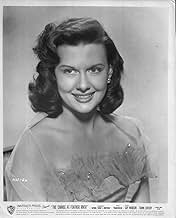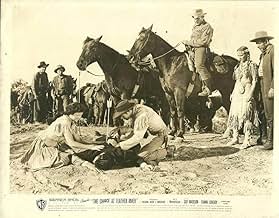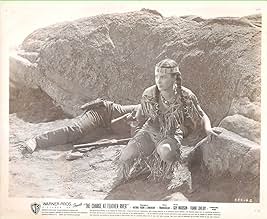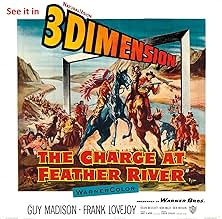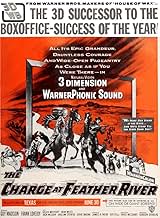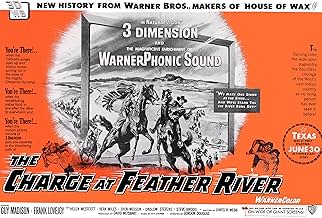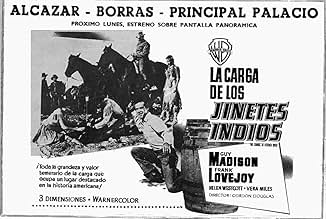In Colorado territory, Miles Archer is asked by the cavalry at Fort Bellows to aid in rescuing two white women abducted by the Cheyenne and to provide security for the railroad construction ... Read allIn Colorado territory, Miles Archer is asked by the cavalry at Fort Bellows to aid in rescuing two white women abducted by the Cheyenne and to provide security for the railroad construction teams.In Colorado territory, Miles Archer is asked by the cavalry at Fort Bellows to aid in rescuing two white women abducted by the Cheyenne and to provide security for the railroad construction teams.
- Director
- Writer
- All cast & crew
- Production, box office & more at IMDbPro
Featured reviews
A decent and personable Western set in Colorado territory, better than you might expect , including the usual hail of arrows to the right of you and spears to he left to you , all of them hurled at the audience and here more inventively augmented by some spectacular Indian charges at Feather River . An ordinary Cavalry Western in which an officer is saddled with the risked assignment of rescue and steer a platoon through hostile Indian territory . Dealing with an exciting story involving Miles Archer (Guy Madison) along with sergeant Baker (Frank Lovejoy) and a group of soldiers (Dick Wesson , Onslow Stevens , Steve Brodie , Ron Hagerthy , Neville Brand , among others) are asked by the cavalry Major at Fort Bellows to aid in rescuing to two white women (both , Helen Westcott and Vera Miles prove more than mere objects in the tale) captured by the Cheyenne . They are rescued 5 years later , one by force (Vera Miles who has turned renegade and is not anxious to be rescued) due to about to marry a chief Thunder Hawk .
The film packs thrills , fights , noisy action , crossfire , Indian charges , and being enough entertaining . It's a medium budget film with comfortable actors , technicians , functional production values and pleasing results. It is a pretty fine picture that could become another western worthy of any anthology . Moving and action-packed Western with a simple , standard story that engages the viewer until the last scene when cavalry comes to the rescue in the nick of time by a stream called Feather River , dealing with an overland journey through hostile Cheyenne territory carried out by a squadron of Privates to rescue and escort two sisters kidnapped by Indians long time ago . Meanwhile , soldiers getting off shots into the surprising spectators as well as knives, arrows, lances and tomahawks all come flying at the audience . Screenline serves mainly as an excuse for non-stop Indian attacks . This was the first 3-D Western and one of the first CinemaScope movie of any kind from Warner Brothers , a studio very committed to the 3D process , and not forgetting the Panoramic shots that showed the new process off to its best effect , using Zeiss anamorphic lenses . Decent and pleasant traditional Western with professional direction and flawlessly acted by Guy Madison as Miles Archer and Frank Lovejoy as Sgt. Baker , both of whom make fortright leads . Guy Madison was one of the most popular Western stars at the time who performed this first 3D Western : ¨The charge of Feather River¨ along with ¨The command¨. Guy played leads in a series of programmers before being cast as legendary lawman Wild Bill Hickok in the TV series Adventures of Wild Bill Hickok (1951). Madison had his first major role in "Until the End of Time" a drama directed by Edward Dmytryk, 1946 to then changed in action roles , mainly series B westerns , get some successes with the series . He played Hickok on TV and radio for much of the 1950s, and many of the TV episodes were strung together and released as feature films. Madison managed to squeeze in some more adult-oriented roles during his off-time from the series, but much of this work was also in westerns. After the Hickok series ended Madison found work scarce in the U.S. and traveled to Europe, where he became a popular star of Italian westerns and German adventure films , such as : ¨Duel at Rio Bravo¨ , ¨7 Winchester for a massacre¨ , ¨Bang bang Kid¨, ¨Five for revenge¨ , ¨Il figlio di Django¨ and ¨Reverend Colt¨ . Support cast is pretty well, full of gritty acting and giving splendidly fortright performances , notably from Frank Lovejoy who discourages a rattlesnake with tobacco , Onslow Stevens , James Brown , Dub Taylor , Ron Hagerthy , Steve Brodie , Ben Corbett , Lane Chandler and Dick Wesson who provides gritty humor , he is a nice comedian who should gone further in movies .
Beautifully and wonderfully filmed by cameraman Perveret Marley . Being filmed on location in Santa Clarita , Santa Ana River, Norco, Vasquez Rocks Natural Area Park , Escondido Canyon Rd., Agua Dulce, California,California . It contains a stirring and adequate musical score by the classic composer Max Steiner . Max 's soundtrack skilfully underscores some the greatest action scenes ever filmed . Actually made with great drive by Hollywood craftsman Gordon Douglas , even though the script is ordinary and ¨deja vu¨ . Douglas directs some of the best action scenes he ever shot . The motion picture was professionally directed by Gordon Douglas , at his best . Gordon directed nearly 100 features and shorts, including five features alone that were released in 1950, and four more in 1951. He was eventually hired by Hal Roach as a gag writer . His first directorial assignments were for Roach's "Our Gang" series . Graduating to features, Douglas stayed with comedies, directing Stan Lauren and Oliver Hardy . Douglas left Roach for RKO, for which he directed about a dozen films from 1942 to 1947, mostly routine programmers. He then went to Columbia for several years, but in 1950 he headed over to Warner Brothers, where he would stay for the next 15 years and where he would find his greatest successes . His westerns and crime dramas for Warners met with critical and financial success, and it was during this period that he made what is considered one of the classic sci-fi films of the era : Them (1954). Often used counter diving angles with camera, for instance when cars or wagons roll. He was an expert on adventures cinema as ¨Black arrow¨ , ¨Fortunes of Captain Blood¨ , both starred by Louis Hayward and Western , as he proved in the films starred by Clint Walker such as : ¨Fort Dobbs¨, ¨Yellowstone Kelly¨ , ¨Gold of seven Saints¨ , Gregory Peck as ¨Only the valiant¨ in similar plot to ¨Chuka¨ , Richard Boone as ¨Rio Conchos¨ considered the best , and on bandits legendary as ¨Doolins of Oklahoma¨ , ¨Great Missouri raid¨, among others. Rating : 6.5/10 .
The film packs thrills , fights , noisy action , crossfire , Indian charges , and being enough entertaining . It's a medium budget film with comfortable actors , technicians , functional production values and pleasing results. It is a pretty fine picture that could become another western worthy of any anthology . Moving and action-packed Western with a simple , standard story that engages the viewer until the last scene when cavalry comes to the rescue in the nick of time by a stream called Feather River , dealing with an overland journey through hostile Cheyenne territory carried out by a squadron of Privates to rescue and escort two sisters kidnapped by Indians long time ago . Meanwhile , soldiers getting off shots into the surprising spectators as well as knives, arrows, lances and tomahawks all come flying at the audience . Screenline serves mainly as an excuse for non-stop Indian attacks . This was the first 3-D Western and one of the first CinemaScope movie of any kind from Warner Brothers , a studio very committed to the 3D process , and not forgetting the Panoramic shots that showed the new process off to its best effect , using Zeiss anamorphic lenses . Decent and pleasant traditional Western with professional direction and flawlessly acted by Guy Madison as Miles Archer and Frank Lovejoy as Sgt. Baker , both of whom make fortright leads . Guy Madison was one of the most popular Western stars at the time who performed this first 3D Western : ¨The charge of Feather River¨ along with ¨The command¨. Guy played leads in a series of programmers before being cast as legendary lawman Wild Bill Hickok in the TV series Adventures of Wild Bill Hickok (1951). Madison had his first major role in "Until the End of Time" a drama directed by Edward Dmytryk, 1946 to then changed in action roles , mainly series B westerns , get some successes with the series . He played Hickok on TV and radio for much of the 1950s, and many of the TV episodes were strung together and released as feature films. Madison managed to squeeze in some more adult-oriented roles during his off-time from the series, but much of this work was also in westerns. After the Hickok series ended Madison found work scarce in the U.S. and traveled to Europe, where he became a popular star of Italian westerns and German adventure films , such as : ¨Duel at Rio Bravo¨ , ¨7 Winchester for a massacre¨ , ¨Bang bang Kid¨, ¨Five for revenge¨ , ¨Il figlio di Django¨ and ¨Reverend Colt¨ . Support cast is pretty well, full of gritty acting and giving splendidly fortright performances , notably from Frank Lovejoy who discourages a rattlesnake with tobacco , Onslow Stevens , James Brown , Dub Taylor , Ron Hagerthy , Steve Brodie , Ben Corbett , Lane Chandler and Dick Wesson who provides gritty humor , he is a nice comedian who should gone further in movies .
Beautifully and wonderfully filmed by cameraman Perveret Marley . Being filmed on location in Santa Clarita , Santa Ana River, Norco, Vasquez Rocks Natural Area Park , Escondido Canyon Rd., Agua Dulce, California,California . It contains a stirring and adequate musical score by the classic composer Max Steiner . Max 's soundtrack skilfully underscores some the greatest action scenes ever filmed . Actually made with great drive by Hollywood craftsman Gordon Douglas , even though the script is ordinary and ¨deja vu¨ . Douglas directs some of the best action scenes he ever shot . The motion picture was professionally directed by Gordon Douglas , at his best . Gordon directed nearly 100 features and shorts, including five features alone that were released in 1950, and four more in 1951. He was eventually hired by Hal Roach as a gag writer . His first directorial assignments were for Roach's "Our Gang" series . Graduating to features, Douglas stayed with comedies, directing Stan Lauren and Oliver Hardy . Douglas left Roach for RKO, for which he directed about a dozen films from 1942 to 1947, mostly routine programmers. He then went to Columbia for several years, but in 1950 he headed over to Warner Brothers, where he would stay for the next 15 years and where he would find his greatest successes . His westerns and crime dramas for Warners met with critical and financial success, and it was during this period that he made what is considered one of the classic sci-fi films of the era : Them (1954). Often used counter diving angles with camera, for instance when cars or wagons roll. He was an expert on adventures cinema as ¨Black arrow¨ , ¨Fortunes of Captain Blood¨ , both starred by Louis Hayward and Western , as he proved in the films starred by Clint Walker such as : ¨Fort Dobbs¨, ¨Yellowstone Kelly¨ , ¨Gold of seven Saints¨ , Gregory Peck as ¨Only the valiant¨ in similar plot to ¨Chuka¨ , Richard Boone as ¨Rio Conchos¨ considered the best , and on bandits legendary as ¨Doolins of Oklahoma¨ , ¨Great Missouri raid¨, among others. Rating : 6.5/10 .
"The Charge at Feather River" is a routine Western about the U. S. Cavalry against the Cheyenne Indians... The film carried a constantly mounting tension with some pleasant diversion...
Guy Madison and Frank Lovejoy play the officers who rescue Helen Westcott and Vera Miles from the Indians...
The outdoor scenes are well photographed, specially the exciting Indian charge at Feather River at the climax of the movie with the rain of spears, the fight to-the-death between Madison and Thunderhawk, the sketches of the Guardhouse Brigade, even a mouthful of tobacco juice used against a rattlesnake, and the romantic interludes between our hero and Helen Westcott... All are here, pictorially entertaining in 3-D and Technicolor...
Guy Madison and Frank Lovejoy play the officers who rescue Helen Westcott and Vera Miles from the Indians...
The outdoor scenes are well photographed, specially the exciting Indian charge at Feather River at the climax of the movie with the rain of spears, the fight to-the-death between Madison and Thunderhawk, the sketches of the Guardhouse Brigade, even a mouthful of tobacco juice used against a rattlesnake, and the romantic interludes between our hero and Helen Westcott... All are here, pictorially entertaining in 3-D and Technicolor...
Warner Brothers produced this 3D extravaganza that was the biggest commercial success for westerns in 1953. Guy Madison leads a band of guardhouse soldiers and misfits to rescue two white women being held by Indians, which essentially all there is to this film. The 3D format was in its early stages as a Hollywood gimmick to compete with the growing popularity of home television, and the effects work very well here. The rescuers make off with the ladies and are pursued by the Indians until the white men make their stand at an island in a creek bed. The Indian weaponry comes at the audience non-stop throughout, and a spray of tobacco juice aimed at a rattler is thrown in for good measure. Madison was quite popular as television's Wild Bill Hickock and is good as a displaced cattle rancher who is given his thankless task by the army. For all the film's polish and presentation, the movie was made in just three days.
Other commentators here have done an admirable job in addressing where "Charge at Feather River" fits in within the canon of Western movies, its similarity to "The Dirty Dozen" and other films of that genre, the use of 3-D effects, and even the origin of the Wilhelm scream. But what about the climactic, epic-making confrontation between Miles Archer (Guy Madison) and Chief Thunderhawk (Fred Carson)? In the action/adventure movies of the 1950s and 1960s, one knows the leaders will meet and fight it out. But when and where and how will it happen?
Thunderhawk has plenty of reasons to want to kill Archer himself. The whites are building a railroad through Cheyenne territory; their rescue effort has led to the death of Thunderhawk's bride-to-be. The cavalry troopers are occupying an island in the middle of the Feather River itself.
In the first charge, the Cheyenne have been repulsed. Their bodies float about the river. Stray horses amble about without direction. But the calm following this is deceptive. The Cheyenne prepare for another charge and this time Thunderhawk will personally take command.
At first, all goes well and a couple of the Guardhouse Brigade are picked off. Then, Thunderhawk commits his fatal mistake. At the head of about thirty to fifty braves, he veers off with only a half a dozen or so warriors to approach the island from the rear while the main bunch of Indians continues to hurl spears and to get shot, falling off their horses, and then bobbing in the river.
Thunderhawk, recognizable in his eagle feather headdress, leads his handpicked braves slowly up an embankment, on their bellies, in preparation for this "stealth" attack. But when they reach the crest of the embankment, above the river's edge, all goes wrong. They are seen too soon and all but Thunderhawk get shot down. Meanwhile, the main war party is beginning to back off.
Thunderhawk, without rifle or spear, cut off from all his men, draws his knife, preparing to do battle with Archer, one against one. Thunderhawk's very life now depends upon his skill with a knife. The bare-chested Cheyenne war chief, confident, powerful, motivated, eager for revenge and victory, squares off against Archer.
After only a few moments, Archer has maneuvered the chief to a slight earthen rise above the embankment, so that the daring, risk-taking, bold Cheyenne war chief stands a little bit above the cavalry officer. Archer goes for Thunderhawk's proud, taut, copper-bronze, native leader belly. As the knife goes in (off camera), Thunderhawk grunts in disbelief and topples, about to fall over the embankment. In a very clever shot, Guy Madison is seen looking over the embankment as Thunderhawk might have seen the view, his last before his death. Thunderhawk gives out a scream of terror as he tumbles down the embankment, splashing into the river. His horse makes way, only slightly, as the chief disappears under the water.
A valiant, determined, daring, native chief has lost his gamble.
Thunderhawk has plenty of reasons to want to kill Archer himself. The whites are building a railroad through Cheyenne territory; their rescue effort has led to the death of Thunderhawk's bride-to-be. The cavalry troopers are occupying an island in the middle of the Feather River itself.
In the first charge, the Cheyenne have been repulsed. Their bodies float about the river. Stray horses amble about without direction. But the calm following this is deceptive. The Cheyenne prepare for another charge and this time Thunderhawk will personally take command.
At first, all goes well and a couple of the Guardhouse Brigade are picked off. Then, Thunderhawk commits his fatal mistake. At the head of about thirty to fifty braves, he veers off with only a half a dozen or so warriors to approach the island from the rear while the main bunch of Indians continues to hurl spears and to get shot, falling off their horses, and then bobbing in the river.
Thunderhawk, recognizable in his eagle feather headdress, leads his handpicked braves slowly up an embankment, on their bellies, in preparation for this "stealth" attack. But when they reach the crest of the embankment, above the river's edge, all goes wrong. They are seen too soon and all but Thunderhawk get shot down. Meanwhile, the main war party is beginning to back off.
Thunderhawk, without rifle or spear, cut off from all his men, draws his knife, preparing to do battle with Archer, one against one. Thunderhawk's very life now depends upon his skill with a knife. The bare-chested Cheyenne war chief, confident, powerful, motivated, eager for revenge and victory, squares off against Archer.
After only a few moments, Archer has maneuvered the chief to a slight earthen rise above the embankment, so that the daring, risk-taking, bold Cheyenne war chief stands a little bit above the cavalry officer. Archer goes for Thunderhawk's proud, taut, copper-bronze, native leader belly. As the knife goes in (off camera), Thunderhawk grunts in disbelief and topples, about to fall over the embankment. In a very clever shot, Guy Madison is seen looking over the embankment as Thunderhawk might have seen the view, his last before his death. Thunderhawk gives out a scream of terror as he tumbles down the embankment, splashing into the river. His horse makes way, only slightly, as the chief disappears under the water.
A valiant, determined, daring, native chief has lost his gamble.
6bux
Slightly above average western drama with the emphasis on action. A cavalry commander (Madison) is forced to recruit from the guard house and set out on a mission to bring back white hostages the Indians have captured. All the expected sterotypes are present, and of course one of the hostages is a beautiful female. Since this one was originaly shot in 3D, be prepared to 'suffer those slings and arrows!'
Did you know
- TriviaWILHELM SCREAM: A scream used for the character Private Wilhelm (recorded originally for Distant Drums (1951)), can be heard when he is shot in the leg by and arrow and painfully lets out a Wilhelm. This famous sound effect has since been re-used in many films, including the Star Wars, The Lord of The Rings and Indiana Jones films.
- GoofsWhen Morgan sets Jennie free, she takes his revolver and then falls from the cliff, taking his revolver with her. In subsequent shots, however, Morgan has a pistol again.
- ConnectionsFeatured in A Star Is Born (1954)
- How long is The Charge at Feather River?Powered by Alexa
Details
- Release date
- Country of origin
- Language
- Also known as
- La carga de los jinetes indios
- Filming locations
- Production company
- See more company credits at IMDbPro
Box office
- Gross US & Canada
- $3,650,000
- Runtime1 hour 35 minutes
- Aspect ratio
- 1.37 : 1
Contribute to this page
Suggest an edit or add missing content

Top Gap
By what name was The Charge at Feather River (1953) officially released in India in English?
Answer

